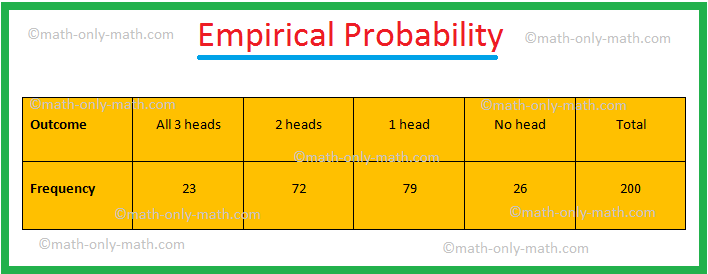Subscribe to our ▶️ YouTube channel 🔴 for the latest videos, updates, and tips.
Empirical Probability
Definition of Empirical Probability:
The experimental probability of occurring of an event is the ratio of the number of trials in which the event occurred to the total number of trials.
The empirical probability of the occurrence of an event E is defined as:
Number of trials in which event occurredP(E) = Total number of trials
If in a random experiment, n trials are carried out and the favourable outcome for the event appears f times, the ratio \(\frac{\textit{f}}{n}\) approaches a particular value p and n becomes very large. This number p is known as the empirical probability
Let a coin be tossed several times. The number of times the head appears for every 20 trials is listed cumulatively in the following table:
|
No. of trials (n) |
20 |
40 |
60 |
80 |
100 |
... |
|
Total number of heads (f) |
13 |
24 |
35 |
44 |
51 |
... |
|
\[\frac{\textbf{f}}{\textbf{n}}\] |
0.65 |
0.60 |
0.58 |
0.55 |
0.51 |
... |
Thus we see that as we go on increasing the number of trials, the value of the fraction \(\frac{\textbf{f}}{\textbf{n}}\), known as relative frequency, approaches the value 0.5, i.e., \(\frac{1}{2}\). Similarly, on several throws of a die, we find that the relative frequency of the appearance of a particular score approaches the fraction \(\frac{1}{6}\) as the number of trials increases.
Thus, from the above experimental results, empirical probability may be defined as follows:
Probability of an event E, symbolically P(E)
= \(\frac{\textrm{Frequency of the Occurrence of the Event E}}{\textrm{Sum of all the Frequencies}}\)
Note: Probability may also be found by using the following formulae:
(i) P(E) = \(\frac{\textrm{The Number of Trials in which Event E Occurs}}{\textrm{Total Number of Trials}}\)
(ii) P(E) = \(\frac{\textrm{The Number of Outcomes in Favour of the Event E}}{\textrm{Total Number of Outcomes}}\)
Now we will solve the examples on different types of experiments and their outcomes such as tossing a coin, throwing of a die etc.,
Solved Problems on Empirical Probability:
1. Three coins were tossed simultaneously 200 times and the frequencies of the different outcomes were as given in the table below:
If the three coins are again tossed simultaneously, find the probability of getting two heads.
Solution:
Let E be the event of getting two heads.
Therefore, P(E) = \(\frac{\textrm{Frequency of getting Two Heads}}{\textrm{Sum of all the Frequencies}}\)
= \(\frac{72}{200}\)
= \(\frac{9}{25}\).
2. Let us take the experiment of tossing a coin.
When we toss a coin then we know that the results are either a head or a tail.
Thus, in tossing a coin, all possible outcomes are ‘Head’ and ‘Tail’.
Suppose, we toss a
coin 150 times and we get head, say, 102 times.
Here we will find the probability of getting:
(i) a head and,
(ii) a tail
(i) Probability
of getting a head:
Then, P(getting a head)
Number of times getting heads
= P(E1) = Total number of trials
= 102/150
= 0.68
(ii) Probability of getting a tail:
Total number of times a coin is tossed = 150
Number of times we get head = 102
Therefore, number of times we get tail = 150 – 102 = 48
Now, let E2 be the event of getting a tail.Then, P(getting a tail)
Number of times getting tails= P(E2) = Total number of trials
= 48/150
= 0.32
Note: Remember, when a coin is tossed, then E1 and E2 are the only possible outcomes, and P(E1) + P(E2) = (0.68 + 0.32) = 13. Consider an experiment of rolling a die.
When we roll a die
then the upper face of the die are marked as 1, 2, 3, 4, 5 or 6. These are the
only six possible outcomes.
Suppose we throw a die 180 times and suppose we get 5 for 72 times.
Let E = event of getting 5
(dots).
Then, clearly, P(E) = 72/180= 0.40
4. Let us take the case of tossing two coins simultaneously.
When we toss two
coins simultaneously then the possible of outcomes are: (two heads) or (one
head and one tail) or (two tails) i.e., in short (H,H) or (H,T) or
(T,T) respectively.
Let us toss two coins randomly for 100 times.
Suppose the outcomes are:
Two heads: 35 times
One head: 30 times
0 head: 35 times
Then, P(E1) = 35/100 = 0.35
Let E2 be the event of getting 1 head.
Then, P(E2) = 30/100 =0.30
Let E3 be the event of getting 0 head.
Then, P(E3) = 35/100 = 0.35.
Note: Remember, when two coins are tossed randomly, then E1, E2 and E3 are the only possible outcomes, and P(E1) + P(E2) + P(E3)
= (0.35 + 0.30 + 0.35)
= 1
Probability
Probability of Tossing Two Coins
Probability of Tossing Three Coins
Probability for Rolling Two Dice
Probability for Rolling Three Dice
From Empirical Probability to HOME PAGE
Didn't find what you were looking for? Or want to know more information about Math Only Math. Use this Google Search to find what you need.



New! Comments
Have your say about what you just read! Leave me a comment in the box below. Ask a Question or Answer a Question.